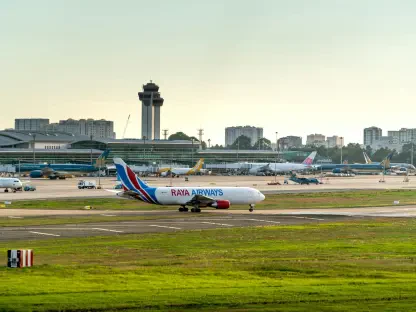In the fast-paced world of logistics, where warehouses buzz with activity, ports handle massive cargo loads, and distribution hubs coordinate endless shipments, a quiet revolution is underway powered by video intelligence. This cutting-edge technology, blending video data with advanced analytics and sensor integration, is reshaping how the industry operates by tackling some of its most persistent challenges. No longer just a tool for security, video intelligence is driving a shift from reactive problem-solving to proactive, real-time decision-making. It’s enhancing safety for workers navigating hazardous environments, streamlining complex operational processes, and building stronger trust with customers through transparency. As logistics firms grapple with the demands of a digital era, this technology emerges as a linchpin for creating smarter, more efficient, and sustainable supply chains. The impact is profound, promising not just incremental improvements but a fundamental transformation of how goods move across the globe.
Revolutionizing Safety Standards
Safety remains a paramount concern in logistics environments where the interplay of heavy machinery, fast-moving vehicles, and human workers creates a high-risk setting. Video intelligence steps in as a game-changer by embedding analytics into camera systems or video management platforms to monitor adherence to critical protocols. For instance, ensuring that personal protective equipment (PPE) is worn becomes an automated process, with real-time alerts issued when violations occur. Exclusion zones can be digitally defined to prevent dangerous interactions between personnel and equipment, significantly reducing the likelihood of accidents. This proactive approach elevates safety from a static checklist of rules to a dynamic, data-driven priority that actively protects lives and mitigates risks in bustling warehouses or crowded ports.
Beyond immediate hazard prevention, video intelligence fosters a culture of accountability and improvement in safety practices across logistics operations. The data collected from compliance monitoring offers insights into recurring issues, such as frequent protocol breaches or near-miss incidents. Managers can use this information to refine training programs, target specific problem areas, and implement corrective measures before accidents happen. This not only lowers the incidence of workplace injuries but also helps companies avoid costly downtime and penalties associated with non-compliance. Furthermore, demonstrating a commitment to safety through such technology can lead to reduced insurance premiums, as insurers recognize the lowered risk profiles. The ripple effect is a safer workforce and a more resilient operation, proving that safety investments yield both human and financial returns.
Enhancing Operational Efficiency
Video intelligence transcends its traditional role in security to become a powerful tool for optimizing logistics operations. One of its standout applications lies in documenting the condition of goods during key stages like unloading and dispatch. High-resolution cameras capture detailed evidence, creating a verifiable record that counters fraudulent claims and prevents unnecessary write-offs. This transparency serves a dual purpose: it saves significant costs by reducing disputes over damaged goods and strengthens customer trust by showcasing a commitment to accountability. Whether it’s a shipment arriving at a distribution center or leaving for its final destination, this visual documentation ensures every step is tracked with precision, turning potential liabilities into opportunities for reliability.
Another dimension of efficiency comes from the ability of video analytics to streamline resource management within logistics facilities. Consider the impact of automating zoned lighting based on occupancy detection—energy consumption drops as lights activate only when and where needed, without compromising safety. Such innovations cut operational costs and contribute to sustainability goals by reducing carbon footprints. Additionally, video data can optimize workflows by identifying bottlenecks in processes like loading bays or sorting lines, enabling managers to reallocate resources effectively. The result is a leaner operation where every movement, from pallet stacking to truck dispatching, is fine-tuned for maximum productivity. This holistic approach to efficiency underscores how video intelligence transforms logistics into a smarter, more cost-effective industry.
Connecting Old and New Technologies
A significant barrier in logistics modernization is the presence of legacy systems that often lag behind digital advancements, yet video intelligence offers a seamless bridge between these older setups and cutting-edge solutions. By converting analog readouts into live data streams, cameras equipped with analytics provide continuous visibility into operations that were previously opaque. Managers gain the ability to set specific thresholds for performance or safety metrics and receive instant alerts when anomalies arise, ensuring issues are addressed before they escalate. This integration breathes new life into outdated infrastructure, allowing logistics firms to remain competitive without the immediate burden of costly system overhauls.
The value of this connectivity extends to maintaining operational continuity while paving the way for broader digital upgrades. Video technology acts as a conduit, linking disparate systems into a cohesive network where data flows freely across platforms. For example, older machinery in a warehouse can be monitored alongside modern IoT devices through a unified video management system, providing a comprehensive overview of activities. This not only delays the need for expensive replacements but also ensures that every asset, regardless of age, contributes to a connected ecosystem. As logistics operations scale, this adaptability becomes crucial, enabling firms to adopt new technologies incrementally while maximizing the utility of existing investments. The result is a smoother transition to a fully digital supply chain.
Fueling Digital Transformation
Video intelligence stands as a cornerstone in the logistics industry’s accelerated push toward digital transformation, a trend gaining undeniable momentum. According to McKinsey, 55% of service providers anticipate adopting numerous digital use cases within the next three years, a stark contrast to the small fraction currently doing so. Video and sensor data play a pivotal role by enabling data-driven decisions directly at the network edge, where real-world events are instantly translated into actionable insights. This capability enhances both reliability and security, aligning with the 85% of logistics companies already reporting tangible value from digital initiatives despite the complexities of implementation. The technology is not just an add-on but a fundamental driver of a modern supply chain.
The broader implications of this transformation are evident in how video intelligence reshapes decision-making across logistics networks. From optimizing delivery routes to predicting maintenance needs for equipment, the insights derived from video data empower firms to anticipate challenges rather than merely react to them. This shift to a proactive stance improves service consistency, reduces operational disruptions, and enhances customer satisfaction through more predictable outcomes. Moreover, the scalability of video solutions means that small initial deployments can expand into enterprise-wide systems, providing a clear path for growth. As logistics continues to evolve, the integration of such technology ensures that firms remain agile, capable of meeting rising demands while navigating the hurdles of digital adoption with confidence.
Sustaining Long-Term Growth and Innovation
The enduring value of video intelligence in logistics lies in its capacity to drive continuous improvement through actionable data. Compliance monitoring, for instance, generates detailed records that reveal patterns of recurring issues, allowing targeted training to address specific weaknesses among staff. Starting with focused implementations like PPE detection builds stakeholder confidence and creates momentum for larger digital projects. Measurable benefits, such as reduced insurance costs from enhanced safety measures, savings on fraudulent claims through visual packing evidence, and lower transportation expenses by optimizing truck fill rates, demonstrate the far-reaching impact. These outcomes reinforce operational resilience and align with sustainability objectives.
Looking ahead, the sustained adoption of video intelligence promises to redefine logistics as an industry of innovation and adaptability. The sharper the video footage and the more robust the edge processing, the deeper the insights that can be extracted, emphasizing the need for strong technological platforms. Logistics firms that invested in these systems found that early successes paved the way for broader transformations, turning initial wins into comprehensive strategies. Reflecting on past implementations, many discovered that fostering a culture of data-driven improvement was key to long-term success. The next steps involve scaling these solutions, integrating them with emerging technologies, and continuously refining processes to stay ahead in a competitive landscape.









